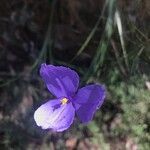Undershrub 30-80 cm tall. Stems woody, few-branched, up to 40 cm long and 5 mm diam. Leaves linear, 10-40 cm long, 2-5 mm wide, flat, finely veined, glabrous; margins minutely tomentose near base. Scape 10-30 cm long, glabrous. Spathes lanceolate, 4-6.5 cm long, finely striate, sparsely sericeous, glabrescent, dark brown; margins 2-3 mm wide, scarious, hyaline. Involucre gaping, up to 4 cm wide; inner bracts fully exposed. Tube 4-5 cm long, glabrous or pubescent. Sepals ovate to orbicular, 2-3 cm long, 1.5-2.6 cm wide, pale violet. Petals lanceolate. Filaments 5-7 mm long, completely connate. Ovary pubescent. Capsule cylindrical, 2-4 cm long. Seeds compressed ovoid, c. 4 mm long, brown; aril linear, appressed.
More
A herb which keeps growing from year to year. It forms tufts. It grows 30-80 cm high and spreads 10-30 cm wide. The stems are 40 cm long by 0.5 cm wide and are woody. They have few branches. The leaves are 10-40 cm long by 0.2-0.5 cm wide. They are flat and spread widely. They are blue-green and have hairs along the edge near the base. The flower stalk is 10-30 cm long. The bract is 4-6 cm long. They are dark brown and spreads 4 cm apart. The flowers are 4-6 cm across and pale blue. The fruit is a capsule 2-4 cm long and like a cylinder. The seeds are brown.

